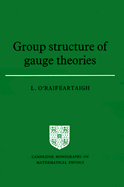Book contents
- Frontmatter
- Contents
- Preface
- Part I Group structure
- 1 Global properties of groups and Lie groups
- 2 Local properties of Lie groups
- 3 Lie algebras
- 4 Hermitian irreducible representations of compact simple Lie algebras
- 5 Continuous unitary irreducible representations (CUIRs) of compact Lie groups
- 6 Rigid internal groups
- Part II Gauge theory
- References
- Suggestions for further reading
- Glossary
- Index
1 - Global properties of groups and Lie groups
Published online by Cambridge University Press: 04 April 2011
- Frontmatter
- Contents
- Preface
- Part I Group structure
- 1 Global properties of groups and Lie groups
- 2 Local properties of Lie groups
- 3 Lie algebras
- 4 Hermitian irreducible representations of compact simple Lie algebras
- 5 Continuous unitary irreducible representations (CUIRs) of compact Lie groups
- 6 Rigid internal groups
- Part II Gauge theory
- References
- Suggestions for further reading
- Glossary
- Index
Summary
Groups
Part I of this monograph is concerned mainly with the theory of Lie groups, which is the background group theory necessary for gauge interactions. But since some of the relevant properties of Lie groups are common to many topological groups, and even to groups in general, it is convenient to begin with a brief discussion of general and topological groups.
First, a group G is denned as a set of elements {g} (not necessarily finite or even countable) for which there is a multiplication law G × G → G (g1g2 ∈ G for g1,g2 ∈ G) with the three properties:
(i) Associativity, g1(g2g3) = (g1g2)g3;
(ii) Existence of an identity element e, such that, for each g ∈ G, eg = ge = g;
(iii) Existence of an inverse element g−1 such that, for each g ∈ G, g−1g = gg−1 = e.
The identity e and the inverse g−1 are easily seen to be unique. In physics and geometry, groups usually occur as transformations which leave some quantity (or set of quantities) invariant, simply because the product of any two such transformations also leaves the quantity invariant. In particular, groups of transformations that leave the Hamiltonian or Lagrangian invariant are called symmetry groups.
An important concept which arises for group transformations is that of group orbits, which may be defined as follows: let a group G of transformations act on a set of elements {s}. Then the subset of all elements that can be obtained from any given element s0 by the action of G is called the orbit of s0 with respect to G, or the G-orbit of s0. For example, the orbits of the rotation group in Euclidean 3-space are the surfaces of the spheres of radius r for each 0 ≤ r < ∞.
- Type
- Chapter
- Information
- Group Structure of Gauge Theories , pp. 3 - 12Publisher: Cambridge University PressPrint publication year: 1986



